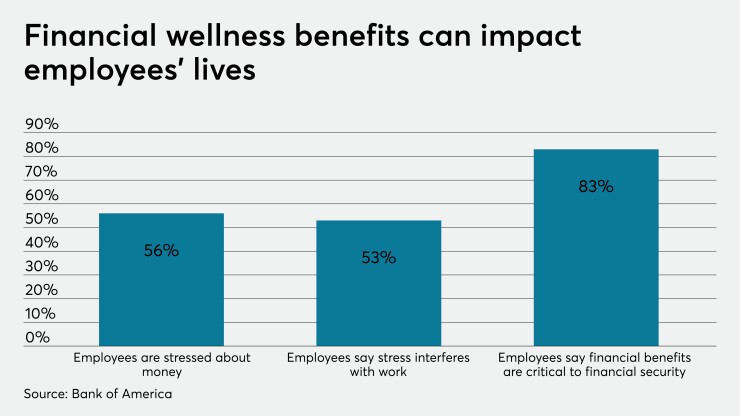Bank of America is offering its employer clients new workplace benefits for their employees to meet their long-term financial needs.
The bank’s Financial Life Benefits offering includes traditional employer-sponsored financial tools like 401(k) and healthcare savings, but adds a corporate employee banking and investment options designed to help an employee with better financial advice, education and digital tools.
“The employee doesn’t look at their financial life in silos,” says Stephen Ulian, head of institutional distribution at Bank of America. “We believe every single employee of a company should have access to advice.”
Financial education is a key component to the employee experience. With a mix of generations in the workplace more employers are getting a better understanding of the unique financial needs of their workers. While a baby boomer may be more focused on their upcoming retirement, millennials and Gen Z may find that scenario too far into the future to think about, and would rather employers offer benefits to address their present concerns, one example being student loan debt.
Still, more employers offer retirement advice to their workers than any other kind. Indeed, 57% of employers offer their employees retirement advice, according to the Society for Human Resource Management. However, only 36% offer financial advice beyond retirement planning. This is where a holistic and comprehensive financial wellness benefit can make a difference to an employee dealing with financial stress.
See Also:
Stress in one aspect of an employee’s life can trickle out into other areas, causing them to become distracted, less productive, and can even impact their health. Indeed, 56% of employees are stressed when it comes to their financial situation, according to Bank of America data. Of these employees, 53% say the stress interferes with their ability to focus and be productive at work. Eighty-three percent of employees agree with the statement: The financial benefits offered by my employer are critical to my financial security.
“Anytime that we can learn and understand nuances with what individuals are going through it better positions us to be in a place to provide that support,” says Lorna Sabbia, head of retirement and personal wealth solutions at Bank of America.
The Bank of America benefit is meant to give employees a complete overview of their financial lives through a single digital platform. Employees at large and mid-size companies will have access to financial education and personalized wealth management through Merrill Lynch advisers. There are also options for onsite group workshops, one-on-one consultations and access to local financial centers to meet with Merrill advisers.
Through the Financial Life Benefits platform Bank of America launched a financial wellness tracker, which is designed to give employees an overview of their basic financial behaviors. The employee answers questions about their financial habits and the tool offers suggestions for behavioral changes to improve their financial situations.
“The next-generation platform really reimagines the digital experience to really help people through all stages of their financial lives,” says John Quinn, head of institutional retirement products and platforms at Bank of America. “That context is extraordinarily important when trying to educate folks on the simple financial behaviors they should be considering.”
Bank of America has been running a pilot program for its own employees over the last year, and plans to offer the platform to all its corporate clients by the summer.
In the past, financial guidance was almost exclusively available to those high net worth individuals, says Ulian. But now employers are in a position to offer financial wellness benefits to employees and help them improve their finances.
“Our 3,000 advisers can work with that group and give them personalized advice as well as digital capabilities and get personalized service the same way someone with $1 million does,” Ulian says.






